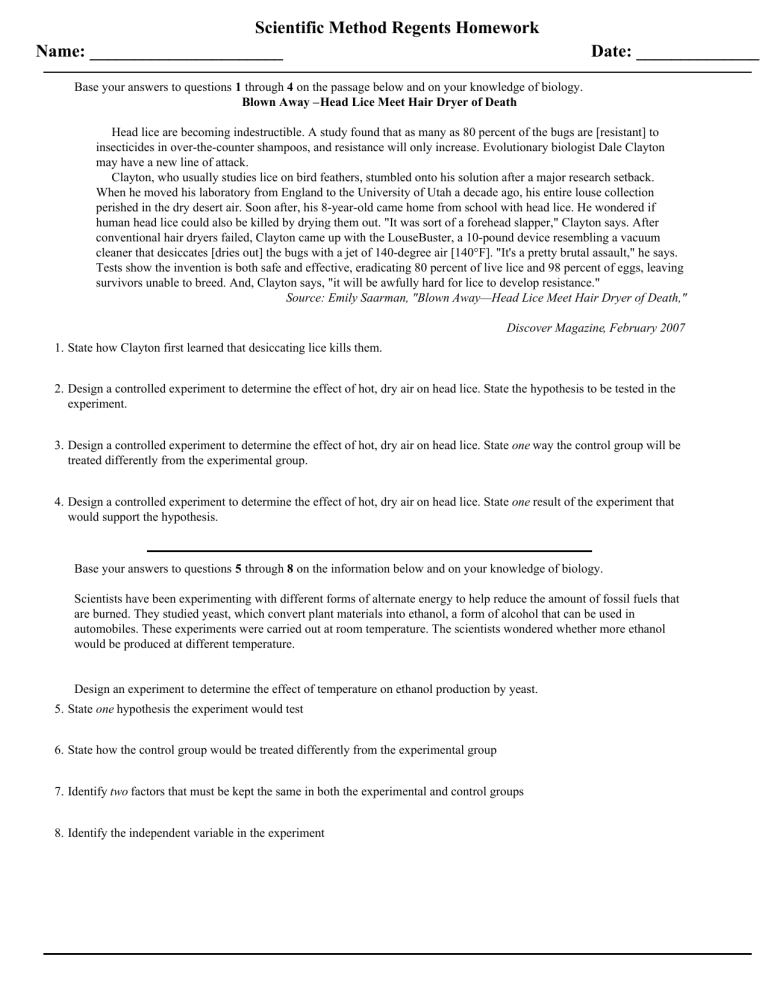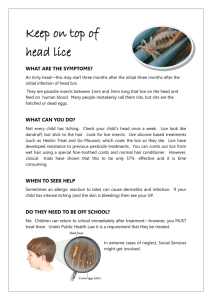
Scientific Method Regents Homework Name: ______________________ Date: ______________ Base your answers to questions 1 through 4 on the passage below and on your knowledge of biology. Blown Away – Head Lice Meet Hair Dryer of Death Head lice are becoming indestructible. A study found that as many as 80 percent of the bugs are [resistant] to insecticides in over-the-counter shampoos, and resistance will only increase. Evolutionary biologist Dale Clayton may have a new line of attack. Clayton, who usually studies lice on bird feathers, stumbled onto his solution after a major research setback. When he moved his laboratory from England to the University of Utah a decade ago, his entire louse collection perished in the dry desert air. Soon after, his 8-year-old came home from school with head lice. He wondered if human head lice could also be killed by drying them out. "It was sort of a forehead slapper," Clayton says. After conventional hair dryers failed, Clayton came up with the LouseBuster, a 10-pound device resembling a vacuum cleaner that desiccates [dries out] the bugs with a jet of 140-degree air [140°F]. "It's a pretty brutal assault," he says. Tests show the invention is both safe and effective, eradicating 80 percent of live lice and 98 percent of eggs, leaving survivors unable to breed. And, Clayton says, "it will be awfully hard for lice to develop resistance." Source: Emily Saarman, "Blown Away—Head Lice Meet Hair Dryer of Death," Discover Magazine, February 2007 1. State how Clayton first learned that desiccating lice kills them. 2. Design a controlled experiment to determine the effect of hot, dry air on head lice. State the hypothesis to be tested in the experiment. 3. Design a controlled experiment to determine the effect of hot, dry air on head lice. State one way the control group will be treated differently from the experimental group. 4. Design a controlled experiment to determine the effect of hot, dry air on head lice. State one result of the experiment that would support the hypothesis. Base your answers to questions 5 through 8 on the information below and on your knowledge of biology. Scientists have been experimenting with different forms of alternate energy to help reduce the amount of fossil fuels that are burned. They studied yeast, which convert plant materials into ethanol, a form of alcohol that can be used in automobiles. These experiments were carried out at room temperature. The scientists wondered whether more ethanol would be produced at different temperature. Design an experiment to determine the effect of temperature on ethanol production by yeast. 5. State one hypothesis the experiment would test 6. State how the control group would be treated differently from the experimental group 7. Identify two factors that must be kept the same in both the experimental and control groups 8. Identify the independent variable in the experiment Scientific Method Regents Homework Base your answers to questions 9 through 12 on the information, diagram, and data table below and on your knowledge of biology. The laboratory setup represented below was used to investigate the effect of light on aquatic plants. Equal amounts of a green water plant were placed in beakers with gas-collecting tubes. The beakers were placed in a temperature-controlled environment. The light source was placed at different distances from the beakers. After an hour, the amount of gas collected from the plants in each tube was measured and recorded in the data table. Scientific Method Regents Homework 9. Provide an appropriate label for the y-axis, including units, on the line provided. 10. Mark an appropriate scale, without any breaks in the data, on each labeled axis. 11. Plot the data on the grid, connect the points, and surround each point with a small circle. 12. Which row in the chart below correctly identifies the variables in this experiment? A) 1 B) 2 C) 3 D) 4


